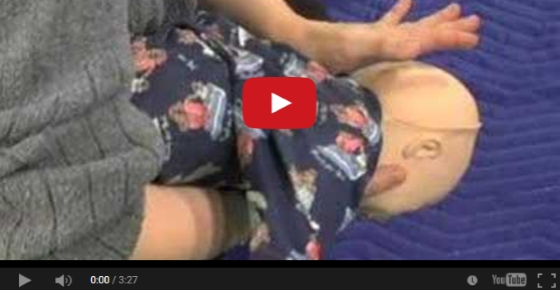Learn How to Save a Choking Baby in 3 Minutes

It’s every parent’s worst fear: your baby appears to be choking, and you don’t know what to do to help. Try as you might to put small objects up on the highest shelves and keep coins in your wallet and nuts and seeds locked away securely, babies can sometimes manage to get a hold of things they shouldn’t—and inevitably, they put these things in their mouths.
Sometimes, this can lead to choking. So, what can you do when your best efforts to avoid this situation are for naught and your infant is choking?
Learn the simple steps to save a choking baby so that you can be ready in case this emergency situation should happen while you are present. Here are written instructions followed with two videos on how to to save a choking baby.
Infant First Aid – How to Save a Choking Baby
Step 1: Evaluate the situation
- If the baby is making strange noises (wheezing, gagging, or choking/coughing sounds) while opening his mouth, his breathing may be partially impeded by a foreign object.
- If the baby is silent with mouth open and turning red, blue or purple, his breathing may be completely obstructed by a foreign object. In either event, the child needs immediate help in order to begin breathing again.
Please note that if the baby is crying loudly or is coughing hard, he may be able to dislodge the object on his own by using the coughing reflex. However, if the cough is very weak or not present and the baby appears to be choking, rescue attempts should be made.
Step 2: Attempt to clear the object from the airway
Blows to the back
- While sitting, place your non-dominant forearm palm-up along the top of your thigh.
- Lay the baby face-down along your forearm, so his belly is along your arm, and support his jaw with your hand. Note: the baby’s head should be lower than the rest of the body while doing this.
- Using your dominant hand, strike the baby firmly between the shoulder blades up to five times.
Abdominal thrusts
If the strikes to the back do not help to remove the foreign object from the baby’s airway, turn him over and begin abdominal thrusts.
To do this, lay the baby on your lap and support his head with your non-dominant hand.
- Continue to keep the head lower than the rest of the body.
- Using your dominant hand, place two fingers in the center of the baby’s chest, just below the level of the nipples.
- Press down one-third to one-half the depth of the chest (or one and a half inches) and repeat this thrust five times.
- Repeat this cycle of five strikes to the back followed by five abdominal thrusts until the foreign object has cleared the airway.
Step 3: If dislodging attempts fail, initiate CPR
If the object does not dislodge after repeated back blows and abdominal thrusts, and the baby becomes unconscious in spite of these efforts, call the emergency number right away and initiate infant CPR, outlined below, until help arrives.
Here is a video demonstrating how to save a choking baby. After watching this video, scroll down to learn how to perform CPR on an infant child.
How to Perform CPR on an Infant Child
Step 1: Perform a further evaluation of the baby
- Check the baby for any injuries or bleeding.
- If the child is bleeding, CPR must not be performed until the flow of blood has been stanched by applying pressure.
- Check for consciousness by tapping on the baby’s foot.
- Check the mouth and throat for a visible foreign object. If you see one, attempt to clear it by using a finger.
- If the baby is unresponsive, initiate CPR until help arrives.
Begin by placing the baby on a flat and firm surface.
Step 2: Open the air passage
- To open the air passage, tilt the infant’s head back slightly with one hand while lifting his chin just a bit with the other hand.
- Take just a few seconds (no more than ten) to check for signs of breathing.
- Listen at the baby’s mouth for breathing sounds and watch the chest for signs of rising and falling.
If the baby isn’t breathing, move on to the third step.
Step 3: Perform mouth-to-mouth
- Covering the baby’s nose and mouth with your mouth, breathe gently into the baby’s lungs. You should see his chest rise and fall with your breaths.
- If the chest does not rise in response to your breath, try tilting the head slightly to the side and attempting the mouth-to-mouth again.
- Repeat these breaths twice. If the breaths have no effect on the infant’s consciousness, initiate chest compressions.
Step 4: Perform chest compressions
- To perform chest compressions, place two fingers in the center of the infant’s chest as outlined above for the performance of abdominal thrusts.
- Compress the chest one-third to one-half the depth of the chest 30 times, keeping at a rate of about 100 compressions per minute.
- Each cycle of mouth-to-mouth breaths and chest compressions should take no more than 30 seconds.
Step 5: Continue to cycle through mouth-to-mouth and chest compressions
Continue to perform cycles of mouth-to-mouth and chest compressions until help arrives.
Even if the baby regains consciousness and is able to dislodge the foreign object following CPR, he will still need to be evaluated by a medical professional to ensure that the object is entirely clear of the airway and that no internal injuries have occurred as a result of his ordeal.
Read other articles that can save lives:
Early Signs of Stroke – Discover the Warning Signs that Can Save Life
10 Signs of a Heart Attack Never to Ignore
Discover the 5 Unconventional Signs of Breast Cancer
